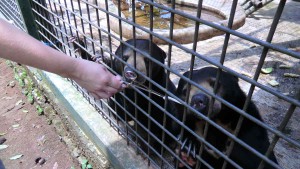by Grace Fuller
Lately my work with lorises in Java has led me to spend a lot of time with the other residents of Cikananga Wildlife Center. One of the possible functions of slow loris venom is to repel predators, and I have been testing this hypothesis by observing behavioural reactions of potential loris predators to samples of venom collected from the Little Firefaces. So far, I have conducted tests with Malayan sun bears, orangutans, and three species of eagles: Javan hawk eagles, changeable hawk eagles, and crested serpent eagles. There are confirmed cases of orangutans and changeable hawk eagles predating on slow lorises in the literature, so the lorises have reason to be wary of these species!

To conduct these tests, I offer a sample of the venom with a piece of food, which ensures that the predator is motivated to explore the test item. For the bears, this means wrapping a venom sample collected on a tissue around a piece of rambutan (a tasty local fruit) and sealing it with a drop of honey. In the future, I will be testing Javan leopards and other felid species at Cikananga, and I am hoping to venture outside the rescue center to conduct further tests with other potential predators including tigers, civets, and snakes. I have also been working with the sun bears to collect saliva samples (see photo) which I plan to use to measure hormones to determine if the loris venom elicits a stress response in the bears. Stay tuned for what I hope will be some interesting results!
